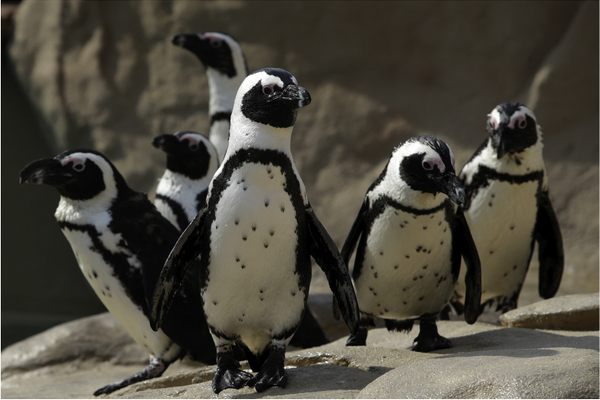Brooklyn, Borough of the Birds: A Report from a Wild Parrot Safari
Parrots in Brooklyn (all photographs by the author)
In the early 2000s, New York local Steve Baldwin heard rumors about wild parrots living on Brooklyn College’s campus. “I thought it was an urban legend,” he told Atlas Obscura, “like with the alligators in the sewers.” A parrot lover himself, he decided to investigate — and learned it was true. And the more Baldwin learned about the wild parrots, the more he liked them. Today, he is the parrots’ self-appointed public advocate, maintaining the web site Brooklyn Parrots and leading guests on free “parrot safari” walking tours to meet these birds.
Steve Baldwin leading a parrot safari
Brooklyn’s parrots aren’t jungle birds, nor are they escaped pets. They’re actually Monk Parrots, a smaller South American breed which lives on grass, seeds, and tree buds, and has long been considered an agricultural pest in its original home. In fact, an Argentinian attempt at pest control brought the parrots to New York in the first place.
In the 1960s, the Argentine government started rounding up whole flocks and shipping them north by the crateful, pitching them as pets to the North American market.The scheme worked for a while, as North American pet owners were charmed by the lively, intelligent birds. But the USDA halted the scheme after a couple airports reported cases of crates breaking open, releasing entire flocks into the wild.
The first flock in New York City escaped from JFK Airport in the late 1960s. New York’s climate is similar to Argentina’s, so the parrots adapted well to their new home. On his tour, Baldwin pointed out another trick the Monk Parrots use to adapt to Brooklyn — their nests.
Parrot nesting in Brooklyn
A parrot nest in a Brooklyn tree
Unlike most other parrots, which nest in hollow trees, Monk Parrots weave intricate structures out of twigs, tucking them under eaves and nestling them in branches. And a single nest serves the whole flock — each breeding pair weaves themselves their own little “apartment” onto the main nest. Some of the nests can even reach several feet in diameter. The nests are also surprisingly strong — Baldwin says that some of the nests he monitors withstood 2012’s Hurricane Sandy.
Parrots on the sidewalk
The parrots also withstood a surprising early attack in their new home. Because of their intelligence and their tenaciousness, the USDA feared they would make their way to nearby farms and eat through crops, and were determined to put a stop to their airport escapes. In the early 1970s, they sent snipers to stalk through Brooklyn in an unsuccessful attempt to hunt the parrots down. After a few frustrating missions, they gave up, grudgingly settling for banning further Monk Parrot imports. A handful of states have their own restrictions concerning Monk Parrots’ breeding or ownership.
Fence at a playground, near Brooklyn College
Federal and state governments may be uneasy about these avian immigrants, but their neighbors love them. While leading groups on his tours, Baldwin often chats with locals, asking them about their parrot neighbors. “Oh, they’re celebrities,” one resident told guests on a recent tour. “Our kids love them.”
Brooklyn College considers the parrots unofficial mascots, and tries to look after them as well; during a 2011 renovation of its soccer field, the college redesigned the lights with the parrots in mind, adding extra platforms and structures expressly for the parrots to nest on. They also scheduled their renovation around the parrots’ breeding season.
Parrots patrolling the sidewalk
The neighbors also step up to protect the parrots. Occasionally, would-be breeders try catching some wild parrots for the pet trade. Residents either chase off the parrot-catchers themselves, or scare off the parrots first, spoiling their plans. Baldwin explained that any parrots captured face a cruel fate. “They catch one wild male,” he told Atlas Obscura, “and then one wild female, and try to make them a breeding pair. Then they hand-raise any chicks and sell them to pet stores.” To protect the birds, Baldwin meets his tours well away from the parrots’ nest sites, and asks his guests not to divulge their exact locations.
Congregated parrots
Despite his exhaustive knowledge of the birds and their behavior, Baldwin is not an ornithologist himself — he’s just a fan of the parrots. Baldwin leads his monthly tours in an effort to win more of the public over to the parrots’ side. Other states have considered rounding up their own parrot colonies and “deporting them” back to Argentina, but Baldwin wants to see Brooklyn’s parrots stay put.
“They give a neighborhood an exotic flavor,” he told Atlas Obscura, “and they also give you a reason to visit a neighborhood you wouldn’t visit otherwise.” The more fans he wins for the parrots, he figures, the more likely New Yorkers will want them to stay.
A tableau of NYC wildlife
Baldwin offers his “Wild Parrot Safaris” monthly, all year-round. His tours are free, but Baldwin asks visitors to “consider donating bird seed.” To reserve a spot, and to learn more about Brooklyn’s parrots, you can visit his site: brooklynparrots.com.

















Follow us on Twitter to get the latest on the world's hidden wonders.
Like us on Facebook to get the latest on the world's hidden wonders.
Follow us on Twitter Like us on Facebook